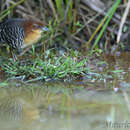Biology
provided by Arkive
This is a very poorly-known species, with very little information regarding its diet, behaviour or breeding, which suggests that this bird is very secretive. It uses runways in grass made by small mammals or water channels (4).
Conservation
provided by Arkive
The rufous-faced crake occurs in a number of protected areas, such as Brazilia National Park, Brazil; Paso Bravo National Park, Paraguay and Estación Biológica Beni, a UNESCO-MAB Biosphere Reserve in Bolivia (3). However, such areas offer differing levels of protection, and one specific proposed conservation measure is to implement effective protection of Paso Bravo National Park. Surveys to determine its exact distribution have also been proposed, particularly concentrating on the large gaps in its known distribution where there is similar habitat (3).
Description
provided by Arkive
This small, but distinctive bird is a member of the rail family Rallidae, a group of ground-dwelling birds, and gets its common name from the strong yellowish pink to orangey-red colour of its head and neck. The back, wings and fairly long tail are dark brown, and the feathers at the leading edge of the wing are barred blackish-brown and white. The underparts are white, and barred black on the belly (2) (3). Its stout bill is blue-grey, as are its legs and feet, and the iris is red. Males and females are very similar in appearance (4).
Habitat
provided by Arkive
The rufous-faced crake inhabits grasslands, with dense tussock-grasses, in shallowly flooded or marshy areas, often with around 3 cm of standing water (2).
Range
provided by Arkive
Occurs in only approximately ten locations distributed over eastern Paraguay, central Brazil and central Bolivia (2).
Status
provided by Arkive
Classified as Vulnerable (VU) on the IUCN Red List 2006 (1).
Threats
provided by Arkive
A large portion of the rufous-faced crake's range lies within the Cerrado, a vast tropical savanna covering parts of Brazil, northeastern Paraguay and eastern Bolivia. By 1993, two-thirds of the Cerrado region had been either converted or heavily modified, for human activities such as agriculture and cattle-ranching (3) (5). This is likely to have drastically reduced the amount of suitable habitat available for the rufous-faced crake. This continues to be a threat, and an increase in human population within this region will increase the pressure on the remaining intact vegetation (5). Fire is an additional potential threat to this species, although it does appear to tolerate some burning. A more significant threat to the rufous-faced crake is the widespread use of pesticides, fertilisers and other chemicals (2) (3).

